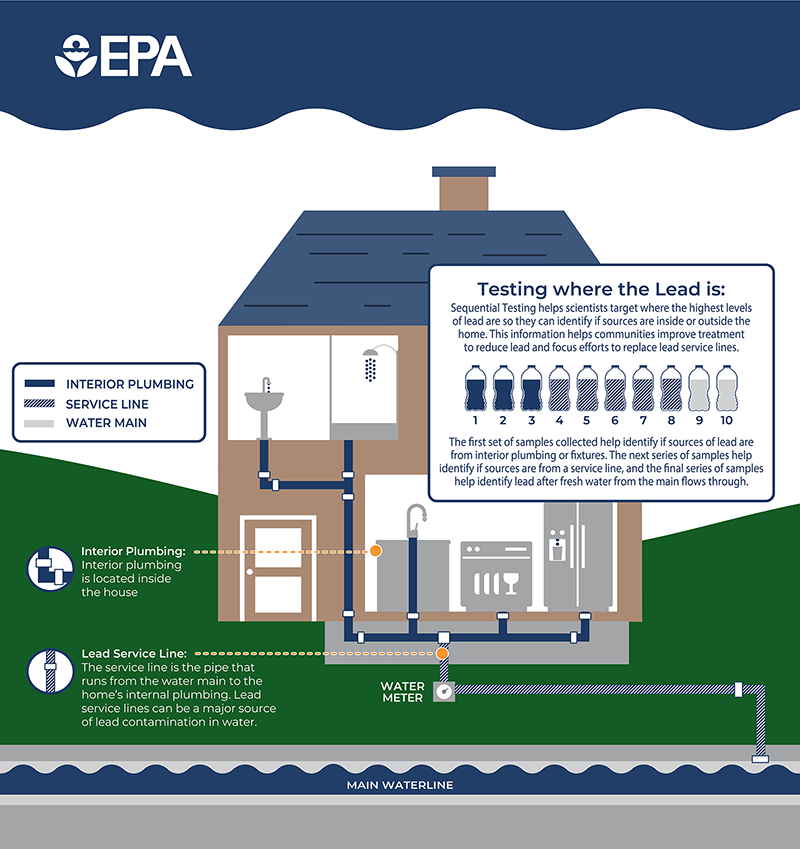Benton Harbor, Michigan, Drinking Water Study Results
EPA conducted three studies to support residents in Benton Harbor, MI, a community known to have high levels of lead in their drinking water.
- EPA researchers conducted a filter study focused on evaluating faucet and pitcher filters to make sure they were reducing lead as expected.
- They also conducted a sequential study to determine the sources of lead within the plumbing, from the tap, throughout the home, to the service line.
- And finally, EPA researchers conducted a particle study to determine the size and type of small particles in drinking water.
Certification for filters used in the filter study is based on NSF/ANSI 42 & 53 standards for faucet filters and NSF/ANSI 53 for pitcher filters. Over 230 total homes were sampled to support the three studies.
EPA coordinated these studies along with Michigan Department of Health and Human Services, Michigan Department of Environment, Great Lakes, and Energy, Berrien County Health Department, City of Benton Harbor, and Lake Michigan College. MDHHS, in partnership with local support, continues to distribute bottled water to ensure access to safe drinking water in Benton Harbor. Benton Harbor residents should continue to follow state recommendations for drinking water use. Those recommendations can be found on the City of Benton Harbor Water Efforts webpage.
Filter Study
Drinking water was sampled for lead and other metals before and after passing through certified faucet and pitcher filters. Samples were collected from all filter brands currently being provided in Benton Harbor by the Berrien County Health Department. In the unfiltered water samples, the lead concentrations were detected up to 77 parts per billion (ppb). After the water was run through properly installed and operated filters, all samples had lead results below 5 parts per billion, the level that the filters were certified to reduce lead below. Most filtered water had no reportable lead in the samples (the detection limit for lead is 0.5 ppb). This means that filters, when properly installed and used, remove lead from drinking water as expected. The interactive viewer below shows lead levels of unfiltered and filtered water at homes in Benton Harbor. Analysis of other metals was also completed as reported in the Full Study Report section below.
The map on the right shows that when filters are used correctly, lead results were less than 5 parts per billion (ppb), the certification standard for drinking water filters.
Sequential Study

The researchers also applied sequential sampling – taking multiple unfiltered water samples from the customer’s tap, one after another, to determine the sources of lead in the home. The study also helps determine if corrosion control is working. Corrosion control is a process done at the drinking water plant to help reduce lead from leaching into water. The concentrations of lead in the samples tell us where lead is present in the home’s plumbing from the tap through the service line. Examples of lead products in plumbing include brass fixtures, solder, galvanized water lines and lead service lines. EPA conducted sequential sampling in 26 Benton Harbor homes. The result profiles can be viewed in the interactive viewer below. The maximum concentrations in the series of samples ranged from 3 to 391 parts per billion.
The graphic (left) generally describes how and where sequential samples are collected. In Benton Harbor, the first two samples were collected in 125 milliliter (ml) bottles to examine fixtures and plumbing near the faucet. The remaining samples were collected in 500 ml bottles. An additional 1-liter bottle was collected for the particle study.
Testing all of these samples for lead helped us create a profile of lead levels throughout the plumbing at each home.
Particle Study
The purpose of the particle study was to inform EPA and the community on the types and size of small particles that are present in the drinking water. These samples were collected along with the sequential samples. The analysis showed that when lead was found, it was generally detected in larger clumps of particles. Extremely small particles, or nanoparticles, were not common. Generally, larger particles are more easily removed by filters. Refer to the full Study Report below for more information about the Benton Harbor particle study results, as well as the Filter Study above for more information about filter effectiveness in Benton Harbor.
Full Study Report
EPA completed final analysis of all data collected during the three concurrent Benton Harbor Drinking Water Studies. These additional analyses help to further explain the composition of the plumbing materials and how lead was being released into the drinking water during the study time period, along with certified drinking water filter performance and the presence of particulate lead. EPA Office of Research and Development published the final Benton Harbor Drinking Water Study Report on April 14, 2023.
Final Benton Harbor Drinking Water Study Report (April 2023, 9978.059 KB)
This study is just one of many ways in which EPA is working with the city, state, county, and community to ensure that Benton Harbor residents have access to safe drinking water. For more information, please visit EPA’s Benton Harbor website.
EPA provided preliminary lead results as well as all final analytical results to study participants in late 2021 and early 2022.
Data Report: Summary of Lead Water results in Filter and Sequential Studies (pdf)
